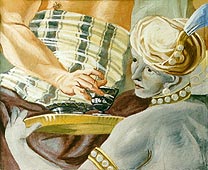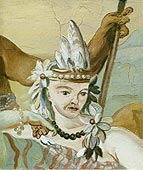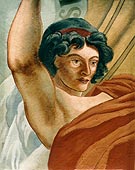|
|||||||||||||||||||||||||||||
 |
 |
 |
|||||||||||||||||||||||||||
 |
These copies in original size are showing parts of the baroque interior decoration of the garden-pavillion in the park of Benedictine Monastery of Melk. Klaus Mueller executed these copies in life-size on "transportable pieces of wall" (in wooden boxes) at the age of 21 to study and practice fresco-technique and in appretiation of the original great baroque artist Johann Wenzel Bergl, who executed this wall decoration in 1763/64. Bergl also worked in Schönbrunn palace (Vienna), where he decorated the walls in the so called "garden-hall". | ||||||||||||||||||||||||||||
|
Due to a misunderstanding, today the word "fresco" is very often used in general for any kind of mural painting in diverse secco-techniques (=painting on dry wall underground). What is fresco-technique?Painting in fresco means, to apply pigments on to a wall (brick or stone or suiteable under-construction) which is covered with plaster (slake-lime and sand in various compositions), which is still in a wet condition. (fresco=fresh) The plaster has to be in a drying-state just strong enogh to resist pressure-force of the painters brush. In the same way it must be wet enogh to support the binding-process of the pigments to the wall. Therefore only a more or less wide time-window allows the artist to finish his work entirely. The binding of pigments to the wall in fresco happens by the upbuilding of a lime-sinter on the very surface of the plastered/painted wall. This sinter is built up on the surface of the fresh lime/pigment-layer by the water evaporating the wall during the drying process. The presence of the (natural) CO2 in the air is also essential for the chemical reaction of the hardening-process of any lime-plaster. Obviously only lime-resistant pigments are suiteable for fresco-painting. The lime itself takes the part of „white“ in this technique. Because of remarkeable color change between the fresh and the final dry colors, painting in fresco is quite a challenging task that requires a lot of experience and knowledge by the artist. |
|||||||||||||||||||||||||||||
 |
 |
 |
|||||||||||||||||||||||||||
| Here you see four more copies in fresco-technique like above. (size is 100x80 cm each) They depict life-size motives from the ceiling of the old University church of Vienna (Jesuitenkirche), which is also famous from the perspective-paintings of "Canaletto". The original decoration of this ceiling was invented and executed in 1703 by the famous Roman painter Andrea Pozzo, but because of bad condition removed and reconstructed in the same way in the 19.th century by the Viennese painter Johann Peter Krafft. During the restauration of this ceiling-decoration in 1994, Klaus Mueller took the unique chance to study the particular faults and practice fresco technique working directly on the scuffolding with the original just in reach of the hand. | |||||||||||||||||||||||||||||
 |
|||||||||||||||||||||||||||||
| Following, you see own designs by Klaus Mueller, all executed as examples for fresco technique: | |||||||||||||||||||||||||||||
 |
 |
 |
 |
||||||||||||||||||||||||||
 |
 |
 |
 |
||||||||||||||||||||||||||
|
Portraits | Landscapes | Figures | Watercolors | Diverse Sujets | Drawings | Etchings | Illustrations | Fresco | Other Projects
Stamps&Postcards | About the Artist | Contact | Commissions | News | Guestbook | Links |
|||||||||||||||||||||||||||||